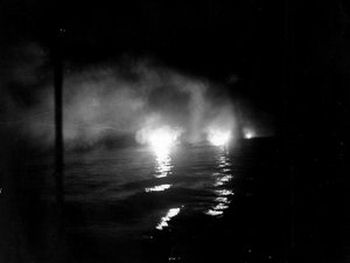
Publisher:
Bonnie King
CONTACT:
Newsroom@Salem-news.com
Advertising:
Adsales@Salem-news.com

~Truth~
~Justice~
~Peace~
TJP
Jan-03-2008 19:16

 TweetFollow @OregonNews
TweetFollow @OregonNews
Missing Sailor from WWII Identified
Salem-News.comThe sailor was aboard a sunken cruiser, but his remains were found on a nearby island.
 The last moments of the U.S.S. Helena during WWII just before she was sunk by Japanese torpedoes Photo courtesy: content.answers.com |
(WASHINGTON, D.C.) - The Department of Defense POW/Missing Personnel Office announced today that the remains of a U.S. serviceman, missing from World War II, have been identified and will be returned to his family for burial with full military honors.
He is Seaman 1st Class General P. Douglas, U.S. Navy, of Newcomb, Tennessee. He will be buried January 26th in Sneedville, Tennessee.
Military authorities say that on July 6th 1943, the light cruiser "USS Helena" was struck by torpedoes fired by Japanese destroyers off the coast of Kolombangara Island, Solomon Islands, in what would become known as the Battle of the Kula Gulf. More than 700 servicemen were rescued, but Douglas was one of more than 150 servicemen who were missing as the ship sunk.
In June 2006, a resident of Ranongga Island, Solomon Islands, notified U.S. officials that he exhumed human remains and Douglas' dog tag that he found eroding out of the ground near a trail by his village.
The officials contacted JPAC, the Joint POW/MIA Accounting Command, who subsequently traveled to Ranongga Island to examine the burial location where they verified that no additional remains were present.
Among dental records, other forensic identification tools and circumstantial evidence, scientists from JPAC and the Armed Forces DNA Identification Laboratory also used mitochondrial DNA in the identification of the remains.
They did not suggest how Seaman Douglas' remains ended up on the island when his ship sunk at sea.
During World War II the island and the waters around it were the scene of fighting with the Japanese using an airstrip on some flat ground at Vila on the south shore of the island, and in May 1943 based several military units on the island, under the command of Major General Noboru Sasaki, in an attempt to establish a defense line through the Central Solomons.
Naval battles nearby included the battle of Kula Gulf and battle of Kolombangara. The most famous battle was the mission to intercept the Tokyo Express supply convoy which resulted in the ramming and subsequent rescue of John F. Kennedy and the crew of his PT-109 by Solomon Islander scouts. The Japanese evacuated Kolombangara between September 23rd and October 4th 1943.
In January 1944 a detachment of 1 officer and 6 enlisted men from the 350th Engineer General Service Regiment stationed at Munda, established a vegetable farm on the Japanese abandoned airstrip at Vila. The British government furnished 16 male natives to help with the project.
With seeds acquired through the Red Cross, many vegetables were sent back to the base hospital to supplement the dehydrated meals served the recuperating veterans. The main item was watermelons that both natives and men enjoyed. The natives were taught how to save the seeds and replant them in their own gardens.
Today the island's main industry is logging.
Articles for January 2, 2008 | Articles for January 3, 2008 | Articles for January 4, 2008


googlec507860f6901db00.html



Terms of Service | Privacy Policy
All comments and messages are approved by people and self promotional links or unacceptable comments are denied.
[Return to Top]
©2025 Salem-News.com. All opinions expressed in this article are those of the author and do not necessarily reflect those of Salem-News.com.